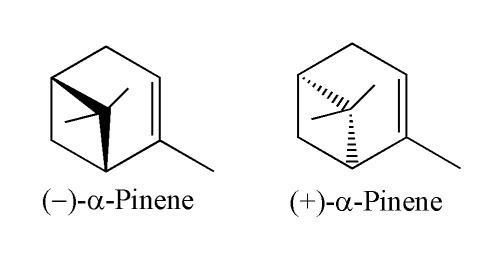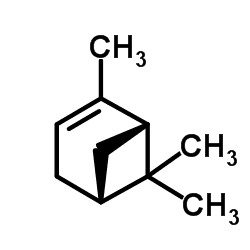Density 858 kg/m³ | Appearance Clear colorless liquid | |
 | ||
Related alkene Related compounds | ||
Reaction of alpha pinene with iodine
α-Pinene is an organic compound of the terpene class, one of two isomers of pinene. It is an alkene and it contains a reactive four-membered ring. It is found in the oils of many species of many coniferous trees, notably the pine. It is also found in the essential oil of rosemary (Rosmarinus officinalis) and Satureja myrtifolia (also known as "Zoufa" in some regions.) Both enantiomers are known in nature; (1S,5S)- or (−)-α-pinene is more common in European pines, whereas the (1R,5R)- or (+)-α-isomer is more common in North America. The racemic mixture is present in some oils such as eucalyptus oil and orange peel oil.
Contents


The four-membered ring in α-pinene 1 makes it a reactive hydrocarbon, prone to skeletal rearrangements such as the Wagner-Meerwein rearrangement. For example, attempts to perform hydration or hydrogen halide addition with the alkene functionality typically lead to rearranged products. With concentrated sulfuric acid and ethanol the major products are terpineol 2 and its ethyl ether 3, while glacial acetic acid gives the corresponding acetate ester 4. With dilute acids, terpin hydrate 5 becomes the major product.

With one molar equivalent of anhydrous HCl, the simple addition product 6a can be formed at low temperature in the presence of ether, but it is very unstable. At normal temperatures, or if no ether is present, the major product is bornyl chloride 6b, along with a small amount of fenchyl chloride 6c. For many years 6b (also called "artificial camphor") was referred to as "pinene hydrochloride", until it was confirmed as identical with bornyl chloride made from camphene. If more HCl is used, achiral 7 (dipentene hydrochloride) is the major product along with some 6b. Nitrosyl chloride followed by base leads to the oxime 8 which can be reduced to "pinylamine" 9. Both 8 and 9 are stable compounds containing an intact four-membered ring, and these compounds helped greatly in identifying this important component of the pinene skeleton.
A variety of reagents such as iodine or PCl3 cause aromatisation, leading to p-cymene 10.
Under aerobic oxidation conditions, the main oxidation products are pinene oxide, verbenyl hydroperoxide, verbenol and verbenone.
Atmospheric role
Monoterpenes, of which α-pinene is one of the principal species, are emitted in substantial amounts by vegetation, and these emissions are affected by temperature and light intensity. In the atmosphere α-pinene undergoes reactions with ozone, the OH radical or the NO3 radical, leading to low-volatility species which partly condense on existing aerosols, thereby generating secondary organic aerosols. This has been shown in numerous laboratory experiments for the mono- and sesquiterpenes. Products of α-pinene which have been identified explicitly are pinonaldehyde, norpinonaldehyde, pinic acid, pinonic acid and pinalic acid.
Properties and usage
At low exposure levels, α-Pinene is a bronchodilator in humans, and is highly bioavailable with 60% human pulmonary uptake with rapid metabolism or redistribution. α-Pinene is an anti-inflammatory via PGE1, and seems to be a broad-spectrum antibiotic. It exhibits activity as an acetylcholinesterase inhibitor, aiding memory. Like borneol, verbenol and pinocarveol (−)-α-pinene is a positive modulator of GABAA receptors. It acts at the benzodiazepine binding site.
α-Pinene forms the biosynthetic base for CB2 ligands, such as HU-308.
